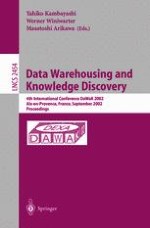Within the last few years Data Warehousing and Knowledge Discovery technology has established itself as a key technology for enterprises that wish to improve the quality of the results obtained from data analysis, decision support, and the automatic extraction of knowledge from data. The Fourth International Conference on Data Warehousing and Knowledge Discovery (DaWaK 2002) continues a series of successful conferences dedicated to this topic. Its main objective is to bring together researchers and practitioners to discuss research issues and experience in developing and deploying data warehousing and knowledge discovery systems, applications, and solutions. The conference focuses on the logical and physical design of data warehousing and knowledge discovery systems. The scope of the papers covers the most recent and relevant topics in the areas of association rules, clustering, Web mining, security, data mining techniques, data cleansing, applications, data warehouse design and maintenance, and OLAP. These proceedings contain the technical papers selected for presentation at the conference. We received more than 100 papers from over 20 countries, and the program committee finally selected 32 papers. The conference program included one invited talk: “Text Mining Applications of a Shallow Parser” by Walter Daelemans, Univer- ty of Antwerp, Belgium. We would like to thank the DEXA 2002 Workshop General Chair (Roland Wagner) th and the organizing committee of the 13 International Conference on Database and Expert Systems Applications (DEXA 2002) for their support and their cooperation.
